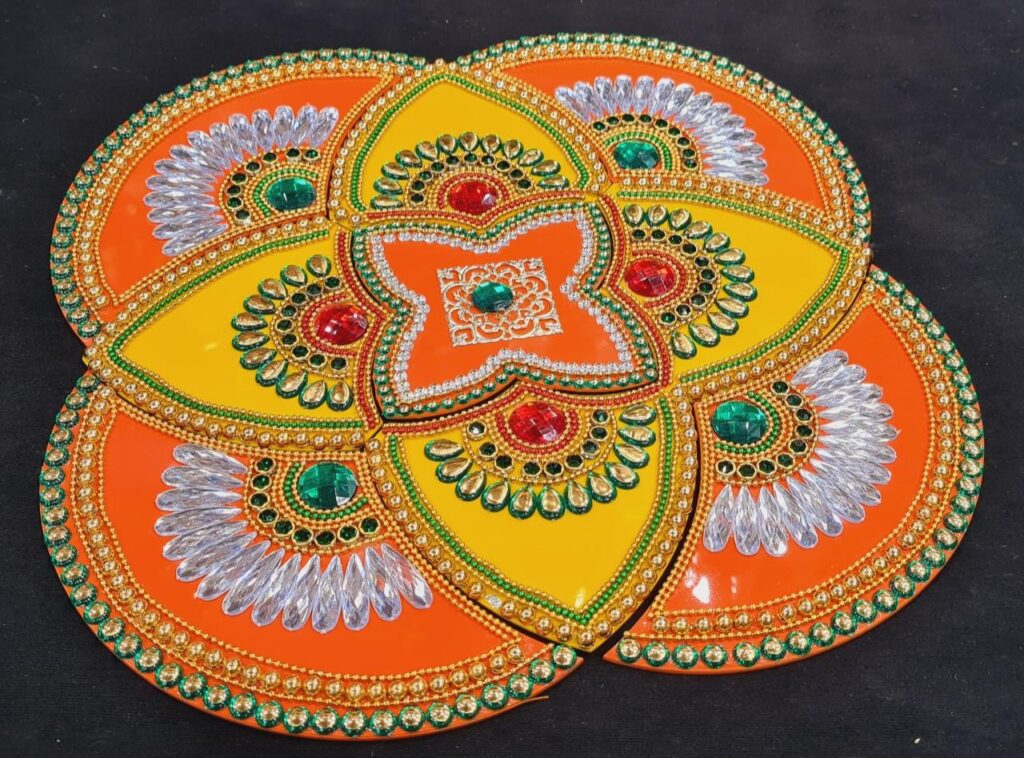Diwali is a mythological eternal festival celebrated every year. It is a festival celebrated on the new moon day of Kartik month and is one of the biggest and important festivals of India. Spiritually it symbolizes ‘the victory of light over darkness’. Among all the festivals celebrated in India, Diwali has great importance both from social and religious point of view. It is also called Deepotsav. ‘Tamaso Ma Jyotirgamaya’ meaning (O Lord!) take me from darkness to light. This is the command of the Upanishads. It is also celebrated by people of Sikh, Buddhist and Jain religions. People of Jain religion celebrate it as Mahavir Moksha Diwas and Sikh community celebrates it as Bandi Mukti Diwas.

It was on the day of Dipawali that King Ram of Ayodhya returned after his fourteen years of exile. The hearts of the people of Ayodhya were filled with joy at the arrival of their most beloved king. The people of Ayodhya lit ghee lamps to welcome Shri Ram. That dark dark new moon night of Kartik month was illuminated with the light of lamps. From then till today, Indians celebrate this festival of lights every year with joy and enthusiasm. Indians believe that truth always wins and lies always perish. Dipawali is the symbol of this – Asato Ma Sadgamaya, Tamaso Ma Jyotirgamaya. Dipawali is a festival of cleanliness and light. Preparations for Dipawali start several weeks in advance. People start cleaning their homes, shops etc. The work of repair, painting, whitewashing etc. starts in the house. People also clean and decorate the shops. The roads in the markets have also been decorated with golden flags. Even before Dipawali, houses, localities and markets all appear clean and decorated.

History
Since ancient times in India, Dipawali has been celebrated as a post-summer harvest festival in the Kartik month of Vikram Samvat. Dipawali is mentioned in Padma Purana and Skanda Purana. These texts are believed to have been written in the second half of the first millennium by expanding some of the central texts. Diyas (lamps) are considered in the Skanda Purana to represent the parts of the Sun, the cosmic provider of light and energy for life and which changes its position in the month of Kartik in the Hindu calendar. In some areas, Hindus also associate Dipawali with the story of Yama and Nachiketa. The story of Nachiketa which tells about right vs wrong, knowledge vs ignorance, true wealth vs temporary wealth etc; Written in the Upanishads of the first millennium BC.

The history of Dipawali is also linked to Ramayana, it is believed that Shri Ram Chandra ji freed Mother Sita from the captivity of Ravana and after her ordeal, returned back to Ayodhya after spending 14 years in exile. The people of Ayodhya had illuminated the entire Ayodhya by lighting lamps to welcome Shri Ram Chandra ji, Mata Sita, and Anuj Lakshman, since then Dipawali i.e. the festival of lamps is celebrated. But you will be surprised to know that Dipawali was celebrated in Ayodhya only for 2 year. In the 7th century Sanskrit play Nagananda, King Harsha has called it Deeppratipadutsavah in which lamps were lit and gifts were given to the new bride and groom. In the 9th century, Rajashekhar in his Kavyamimansa called it Deepmalika in which house were painted and house, streets and markets were decorated at night with oil lamps. The Persian traveler and historian AI Beruni, in his 11th century treatise on India, In the memoir, Dipawali is said to be a festival celebrated by Hindus on the new moon day in the month of Kartik.
Importance
Importance Diwali is most important in India and Nepal. People clean and decorate their houses for this festival. This festival is very good for Nepalese because the new year in Nepal Samvat starts from this day. Diwali is one of the biggest shopping seasons in Nepal and India; During this time people buy expensive items like cars and gold jewelery and clothes, gifts, appliances, kitchen utensils etc. for themselves and their families. Usually people give sweets and dry fruits as gifts to their family members and friends. On this day children hear about ancient stories, legends, myths from their parents and elders about the battle between good and evil or light and darkness. During this time girls and women go for shopping and make rangoli and other creative patterns on the floors, near doors and on the paths. Youth and adults assist each other in arranging fireworks and lighting. There is variation in practices and customs on regional basis. Goddess of wealth and prosperity – Lakshmi or more deities are worshipped. The sky lights up with fireworks on the night of Diwali. Later, family members and invited friends celebrate Diwali with food and sweets at night.

Spiritual Significance
Diwali is celebrated by Hindus, Jains and Sikhs to mark various historical events, stories or myths, but they all symbolize the victory of good over evil, light over darkness, knowledge over ignorance and hope over despair. The Hindu philosophies of Yoga, Vedanta and Sankhya believe that beyond the physical body and mind there is something that is pure, infinite and eternal called the soul or spirit. Diwali is a celebration of inner light over spiritual darkness, knowledge over ignorance, truth over falsehood and good over evil.

Hindu Religion
As stated in the ancient Hindu text Ramayana, many consider Diwali to honor the return of Lord Shri Ram, his wife Mother Sita and his brother Lakshman after 14 years of exile. According to the Mahabharata, another ancient Hindu epic, some consider Diwali to mark the return of the Pandavas after 12 years of exile and 1 year of exile. Many Hindus associate Diwali with Lakshmi, the wife of Lord Vishnu and the goddess of festivity, wealth and prosperity. The five-day festival of Diwali begins on the birthday of Goddess Lakshmi, who was born from the churning of the cosmic ocean of milk by gods and demons. The night of Diwali is the day when Goddess Lakshmi chose Lord Vishnu as her husband and then married him. Along with Goddess Lakshmi, Lord Ganesha symbolizes the remover of obstacles for the devotees; Goddess Saraswati, symbol of music and literature; And the money managers make offerings to Kuber. Some people celebrate Diwali as the day of Lord Vishnu’s return to Vaikuntha. It is believed that Goddess Lakshmi remains happy on this day and those who worship her on this day remain happy throughout the year and stay away from mental and physical sorrows. In the eastern regions of India, Orissa and West Bengal, Hindus worship Kali instead of Goddess Lakshmi and the festival is called Kali Puja. In Mathura and North Central region it is considered to be associated with Lord Shri Krishna. In other areas, the celebration of Govardhan Puja (or Annakoot) involves offering 56 or 108 different dishes to Lord Krishna and is celebrated jointly by the local community. In some western and northern parts of India, the festival of Diwali marks the beginning of a new Hindu year. There are different reasons or stories behind the practice of lighting lamps. According to the devotees of Lord Shri Ram, on the day of Diwali, Lord Shri Ram, the king of Ayodhya, returned to Ayodhya after killing the tyrannical king Ravana of Lanka. Even today people celebrate this festival to celebrate his return. People of Krishna Bhakti sect believe that on this day Lord Shri Krishna killed the tyrannical king Narakasura. The killing of this cruel demon spread immense joy among the people and people filled with joy lit ghee lamps. According to a legend, Lord Vishnu killed Hiranyakashipu by taking the power of Narasimha and on this day Lakshmi and Dhanvantari appeared after the churning of the ocean.

Air Pollution
Air pollution during fireworks is not as bad as after the fireworks, which is found to be about four times the level before the fireworks and twice as bad as the average level on normal days. This study has shown that fine particles of dust remain present in the air after fireworks. This pollution level lasts for a day, and the pollutant concentration starts returning to the original level after 24 hours.
Burning Incidents
There has been an increase in burning incidents every year during Diwali in India. The main reason for burning is firecrackers called pomegranate. Due to which most of the adults become its victims. Along with proper burn care, it is advisable to immediately sprinkle cold water on the burn to help minimize the effects. Most injuries are minor and will heal after first aid. Therefore, during Diwali, especially pomegranate and big crackers should be burnt carefully.

